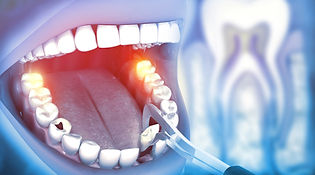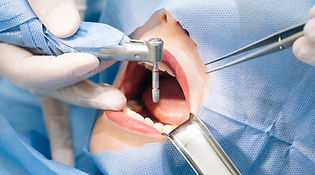
Dental Implants
Implants are a Good Way to Replace Teeth

The questions are:
-
What is a dental implant?
-
When is a dental implant needed?
-
How does a dental implant work?
-
What is the process of installing a dental implant?
-
What are the benefits of a dental implant?
There may come a time when you lose one or more of your teeth.
There are a number of options for teeth reconstruction whether it be for a single tooth, several teeth, or even an entire set of teeth. The best solution begins with a dental implant which basically is an artificial titanium tooth root which fuses to the jaw bone, where other appliances such as a crown, denture or row of teeth can be permanently and securely attached.


When a dental implant is utilized for reconstruction, your new tooth/teeth will function just like your other teeth. There is no slippage or other movement, and taking care of your teeth and mouth is much easier than with a removable appliance.
Types of Dental Implants

Single tooth implants
You may have lost a single tooth due to any number of causes. With a dental implant, your new tooth will look and function just the same as your other teeth. No one, other than you, or someone in your family, will ever know the replacement tooth is not a natural tooth.

Multiple implants
Some patients may be missing more than one tooth. In some cases, it may be necessary to install two implants wherein a fixture can be attached.

Full mouth implants (All-on-X)
In extreme cases, a patient may require the replacement of a full row of upper and/or lower teeth. A minimum of 4 implants will be placed, and the dentist will attach a full arch of artificial teeth.
The Dental Implant Process

The process of placing a dental implant requires multiple steps and can take a number of months depending on a variety of factors.
Our dentists will evaluate your individual needs and provide you with a treatment plan which defines the steps and time required to complete the restoration.

1
The damaged tooth/teeth are removed.
This is accomplished through typical oral surgery methods. We have several anesthesia choices to help relieve pain and anxiety.

2
In certain cases we may need to provide bone grafting which replaces damaged jawbone.
This is required so that the implant can be attached. It takes a number of months for the grafting to take hold.

3
The implant is placed.

4
Once the implant is placed, the tissue surrounding the implant needs time to heal tightly around the implant.

5
An abutment is placed.
The abutment is a device which attaches to the implant and becomes the foundation for attaching the other crown or fixture. It generally takes about two weeks for the gums to heal after the abutment is placed.

6
The replacement tooth or fixture is installed.
And your teeth and mouth are as good as, or better than, new.
Our dentists are accomplished oral surgeons who have been providing simple or complicated mouth restoration for several decades. Once we complete any treatment plan, your mouth will probably work and feel better than it did before you started having dental issues.
Unlike with other reconstructive alternatives, the use of dental implants can last a lifetime.
